Monday, 4 June 2012: Shrek
Written 5 June 2012
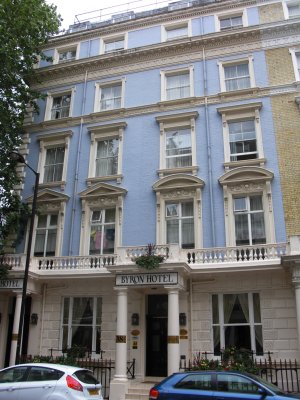
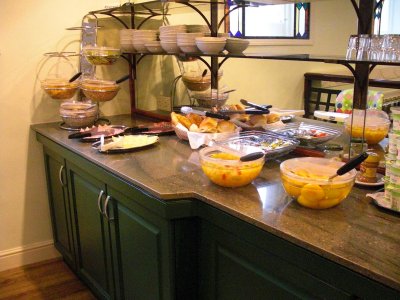
Our hotel (the Byron, on Queensborough Terrace) doesn't have enough tables in the breakfast room for everyone staying there, so they offer four 45-minute seatings (beginning at 8 a.m.), which you must sign up for the night before. A waitress brings you your choice of hot drink and a rack of hot toast (white or whole wheat; I'd have said "rack of hot toast" was an oxymoron, but they managed it; apparently the toast rack is not, as I have always suspected, a deviced invented for the purpose of cooling toast), and the price of the room includes the continental buffet, but for a fee, you can order the full English breakfast (oatmeal, eggs, sausage, bacon, mushrooms, grilled tomatoes). We stuck with the buffet, which includes yogurt, two kinds of canned fruit, milk and several juices, croissants (cold, very British croissants), supermarket-grade bread buns, salami, boiled ham, cheese (sort of like American muenster), and assorted cold cereals (set out, as usual, in open bowls in the humidity; I didn't try them). Honey and peanut butter (both in very small jars) on the buffet; butter and many jams in single-serve packets on the tables.
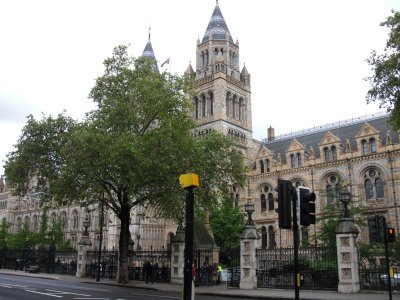
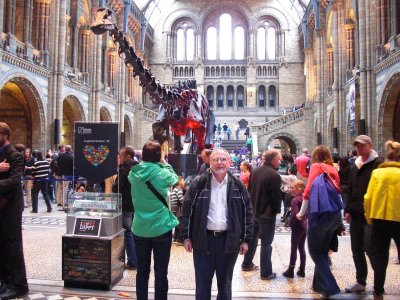
We signed up for the earliest breakfast slot, because we had 10 a.m. (opening time) reserved entry to the Natural History Museum's exhibit on Scott's last expedition (the one on which he and four companions died on the way back from discovering that Amundsen had beaten them to the south pole. Here, on the left is the museum, as we approached it from Brompton Road, and on the right is what greets you as you enter, Dippy (the Diplodocus), the museum's current mascot.
The night before, I had reread the terms and conditions of the entry and discovered, to my dismay, that we would be expected to present the credit card with which the tickets were purchased! Aargh, since I booked the tickets, that credit card had been lost, cancelled, and replaced, and of course we didn't have it with us! I could reconstruct most of the number from memory, but what if they had to scan it? David swore it wouldn't be a problem, and as it turns out, he was right. They didn't even scan the bar codes on the printout, just marked through them with a pen to cancel them and ushered us in.
The exhibit (once again, no photos allowed) was a different take on the expedition, as one might expect—otherwise, why do yet another exhibit on Scott. It was neither the "Scott was Britains greatest hero and a martyr to the spirit of exploration" of 50 years ago nor the "Scott was a headstrong dunce who got himself and others killed" of The Last Place on Earth, which we saw a few years ago on PBS. This one emphasized that (a) planning, funding, and mounting the expedition at all was a great achievement; (b) that the expedition's principal purpose was scientific and that the race to the pole was secondary; and (c) that the scientific part was a great success and its data and specimens (divided between the Natural History Museum and a museum in New Zealand) are still of importance today.
In one of the rooms, the floor plan of the hut at the expedition's main base camp (at Cape Evans on Ross Island) was laid out (this is not the same hut that David photographed during his visit to Antarctica, which was from Scott's previous Antarctic, but subpolar, expedition; that hut was used for a while by part of the shore party of Scott's last expedition). White outlines marked each man's bed, the kitchen, the mess/work table, the lab, Scott's cubicle, etc. The partitions dividing the single large room into different areas were made of stacked crates of supplies. Perhaps the most impressive part of the whole exhibition, for me, was the list of food they brought along. It was a multi-year expedition for 60 men (30 to run the ship and 30 in the "shore party," not all of whom would go as far as the pole) many of whom would overwinter in Antarctica. It took them seven months just to sail from England to the base camp, which they built in nine days and which is still there. It has been intact and stable for a century, but just in the last few years global climate change has begun to cause deterioration, so a team from New Zealand (which cares for the site on behalf of the world community) recently undertook a major stabilization project, including large metal wind baffles set up inland of the hut that will cause drifting show to fly over it rather than burying it.
The end of the exhibition featured videos by scientists in different fields, talking about the importance of Scott's data to their research. One woman talked about the cyanobacteria in the ice-covered lakes, but no mention was made of the endolithic ones in the dry valleys. David knew the guy talking about deep-sea biota. In fact, we know several people who work in the musem, and some of the labs are even open to viewing by the public (through glass walls), but it was a public holiday (for the jubilee), so we didn't bother to go see whether they were in. Some of them will be in Southampton for the symposium, anyway.
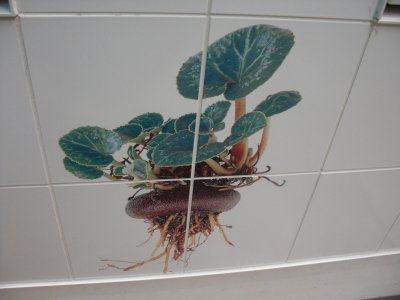
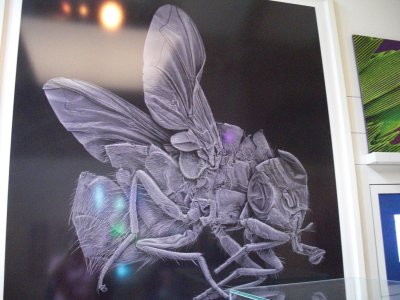 After the Scott exhibition, we wandered through some of the other galleries (the dinosaurs were at the end of a queue of hundreds, with little kids in tow, presumably in town for jubilee, so we skipped that). At one point we encountered, down near the floor, glazed onto white tiles, along with many other images of nature, this gorgeous depiction of a wild ginger plant (at least that's what it's called in the U.S.; it's not the ginger of Asian cooking), slightly larger than life size. At another was this micrograph of a fly, way larger than life size.
After the Scott exhibition, we wandered through some of the other galleries (the dinosaurs were at the end of a queue of hundreds, with little kids in tow, presumably in town for jubilee, so we skipped that). At one point we encountered, down near the floor, glazed onto white tiles, along with many other images of nature, this gorgeous depiction of a wild ginger plant (at least that's what it's called in the U.S.; it's not the ginger of Asian cooking), slightly larger than life size. At another was this micrograph of a fly, way larger than life size.
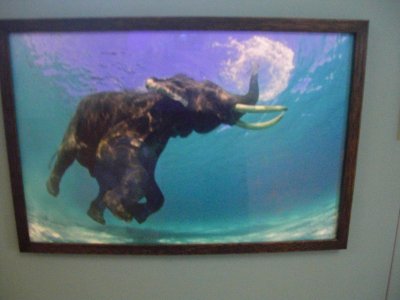
I also encountered little stations that said "Take a card and scan it under this little reader to gather information to look at later on the web. Apparently, kids are supposed to do that, then take the card home, and enter the card's unique number on the museum's website to bring up further information on the subjects that particularly interested them. You could take your card all over the building, sticking it under different card readers to accumulate topics. I took one and scanned it a couple of times to see what comes up when I log in later.
Outside the museum, on the lawn near the snack carts, was a display of photos from one of the nature shows ("The Planet," maybe?). We didn't take time to look at all of it, but I loved this photo of an elephant snorkling.
We had lunch at a nearby pub called the "Hoop and Toy." David said the last time he was there was with Bruce Coull when they were both in London for a copepod conference. It's still officially a "free house" (i.e., a pub not "tied" to a particular brand of beer or ale), but it's now part of a chain of pubs, so the menu was rather generic and didn't actually have the place's name on it. It had all the traditional pub-food items but also included newfangled stuff like pasta al pesto and chicken tikka masala.
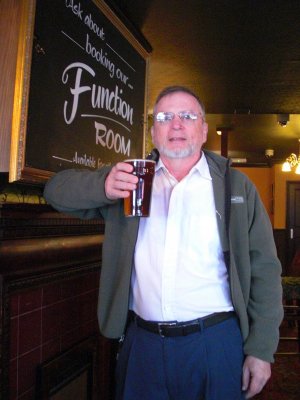
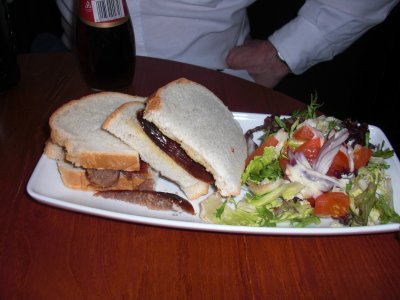 David had a pint of bitter and a "sausage butty" (i.e., a sandwich of split and flattened sausage on buttered bread). For an additional pound, he could have substituted fries for the salad, the opposite of the usual choice in the USA, where fries come standard and salad is extra.
David had a pint of bitter and a "sausage butty" (i.e., a sandwich of split and flattened sausage on buttered bread). For an additional pound, he could have substituted fries for the salad, the opposite of the usual choice in the USA, where fries come standard and salad is extra.
I had the fish and chips (not shown; they looked just like fish and chips). The standard fish was pollock. For extra money, you could get cod, but pollock was fine with me. It came with malt vinegar and tartare sauce, but I asked for mayo as well, for the fries.
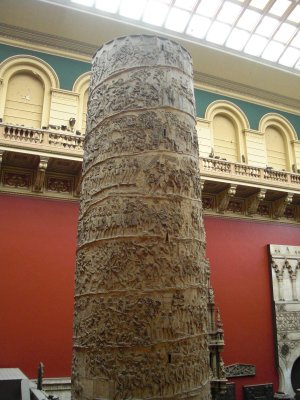
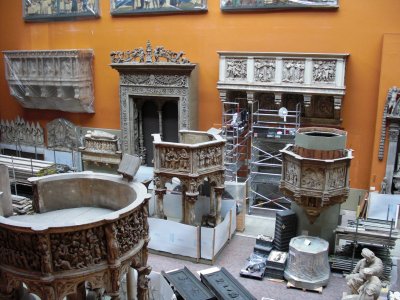 After lunch, we went to the Victoria and Albert museum, right across the street from the Natural History Museum. It has vast collections of, e.g., jewelry carved from shells and semiprecious stones, sculpture (monumental, miniature, and everything in between), "sacred silver" (reliquaries, monstrances, crosses and crucifixes, chalices, plates, etc.), jewelry, painting, stained glass, and "contemporary glass." In addition, in one courthyard is displayed an ancient wooden spiral staircase (now supported by a modern metal framework, as parts of it are missing) and in two other huge glass-roofed courtyards, called the "cast courts, " is a unique collection of plaster casts of monumental art. I don't know how they did it, but they had plaster casts of entire cathedral facades, tombs large and small, carved pillars 10 feet in diameter and three stories tall, a full-size Michelangelo's David—dozens and dozens of such items, all finished to look like the original material, whether stone, bronze, wood, or whatever. One of the cast courts was closed for maintenace, but we could walk around the other one both at floor level and around a balcony at second-story level. At the left here is one of a pair of carved columns, viewed from second-story level looking up toward third-story level (marked by the railing on the opposite wall. How in the world did they cast that?! At the right is the closed court, which we could see down into from the second-story level, for scale, note the young woman in a white coat who is crouching on the scaffolding below the left panel of the right-hand pediment (if that's what that thing to the right of the doorway is called). Below her, resting on the floor, is a collection of stone pulpits.
After lunch, we went to the Victoria and Albert museum, right across the street from the Natural History Museum. It has vast collections of, e.g., jewelry carved from shells and semiprecious stones, sculpture (monumental, miniature, and everything in between), "sacred silver" (reliquaries, monstrances, crosses and crucifixes, chalices, plates, etc.), jewelry, painting, stained glass, and "contemporary glass." In addition, in one courthyard is displayed an ancient wooden spiral staircase (now supported by a modern metal framework, as parts of it are missing) and in two other huge glass-roofed courtyards, called the "cast courts, " is a unique collection of plaster casts of monumental art. I don't know how they did it, but they had plaster casts of entire cathedral facades, tombs large and small, carved pillars 10 feet in diameter and three stories tall, a full-size Michelangelo's David—dozens and dozens of such items, all finished to look like the original material, whether stone, bronze, wood, or whatever. One of the cast courts was closed for maintenace, but we could walk around the other one both at floor level and around a balcony at second-story level. At the left here is one of a pair of carved columns, viewed from second-story level looking up toward third-story level (marked by the railing on the opposite wall. How in the world did they cast that?! At the right is the closed court, which we could see down into from the second-story level, for scale, note the young woman in a white coat who is crouching on the scaffolding below the left panel of the right-hand pediment (if that's what that thing to the right of the doorway is called). Below her, resting on the floor, is a collection of stone pulpits.
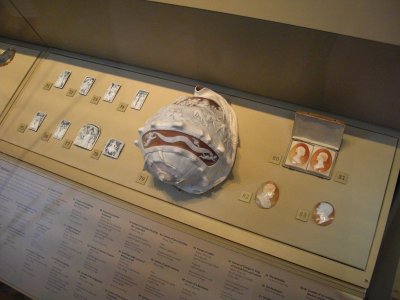
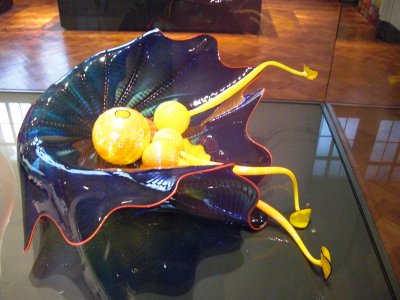 height="300">In the gallery of semiprecious jewelry, we saw a wonderful collection of cameos, including this entire carved conch shell. Among the items of "sacred silver" was, somewhat incongruously, a six-inch cross clad entirely in bright red overlapping Coca Cola labels and titled "The Real Thing" (a wonderful pun, I thought, on that the many pieces of the "true cross" displayed in cathedrals all over the world). In the stained-glass section were very good videos showing the restoration of antique stained glass and some amazing examples of the very old "grisaille" technique of stained glass, in which the image was drawn on plain glass, then fused to it, sometimes with pale color washes over parts of the area. The images could be as detailed as woodcuts, and you don't usually get to see them so close up.
height="300">In the gallery of semiprecious jewelry, we saw a wonderful collection of cameos, including this entire carved conch shell. Among the items of "sacred silver" was, somewhat incongruously, a six-inch cross clad entirely in bright red overlapping Coca Cola labels and titled "The Real Thing" (a wonderful pun, I thought, on that the many pieces of the "true cross" displayed in cathedrals all over the world). In the stained-glass section were very good videos showing the restoration of antique stained glass and some amazing examples of the very old "grisaille" technique of stained glass, in which the image was drawn on plain glass, then fused to it, sometimes with pale color washes over parts of the area. The images could be as detailed as woodcuts, and you don't usually get to see them so close up.

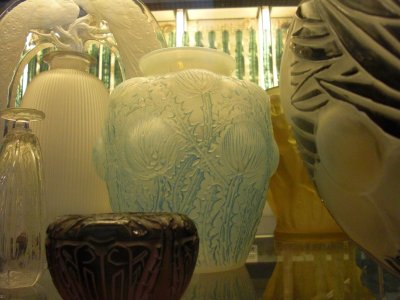 Already shown above, to the right of the conch shell, is a photo from my favorite section of the museum, a piece of contemporary glass by Dale Chihuly. Here are some more—I just can't stop clicking the shutter when faced with modern and art nouveau art glass. At the left are a glass and pitcher with decorative fishes in high relief on the outside. At the right, a vase with a thistle motif. Behind and to the left of the vase is a jar of some sort whose stopper is decorated with wide down-sweeping "wings" on which peacocks are etched. The heads are out of the frame, but you can see parts of the bodies and the tails, which continue down the wings.
Already shown above, to the right of the conch shell, is a photo from my favorite section of the museum, a piece of contemporary glass by Dale Chihuly. Here are some more—I just can't stop clicking the shutter when faced with modern and art nouveau art glass. At the left are a glass and pitcher with decorative fishes in high relief on the outside. At the right, a vase with a thistle motif. Behind and to the left of the vase is a jar of some sort whose stopper is decorated with wide down-sweeping "wings" on which peacocks are etched. The heads are out of the frame, but you can see parts of the bodies and the tails, which continue down the wings.

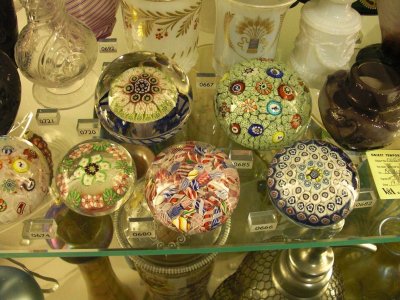 Here, at the left is a sort of life-size glass mummy constructed of bent and molded rectangular glass panels hinged together with loops of wire.
Here, at the left is a sort of life-size glass mummy constructed of bent and molded rectangular glass panels hinged together with loops of wire.
On the right is a small sampling from the museum's large collection of millefiore (and other, equally decorative) paperweights.
We found no still-life to speak of in the painting collections, but among the items in the cast court were replicas of gisants (tomb effigies) we've seen the originals of at Fontivraud (Henry II and Elinor of Aquitaine) and in Rouen (Richard I). We'll presumably be showing the latter to CJ next week. We also saw a tomb the size of a king-size bed and five feet tall but differing from all the others we've seen in that it rested, unusually, on snails. Each snail (presumably, in the original, made of stone) was perhaps a foot long and eight inches tall, and a whole procession of them followed one another around in a rectangle, supporting the plinth of the tomb.
After quick walks through many other galleries (including one displaying the collection donated by a prominent Greek family leaving in London, which included a piano densely decorated with painted floral designs, in the style usually used for harpsichords), our feet began to give out. At that point, we had not seen half of what the museum offered, and we never even considered taking time to view the current special exhibition, "British Design," but we chose to rest up for a while, so we adjourned to the building's central courtyard.
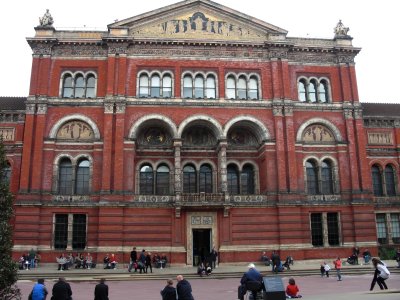
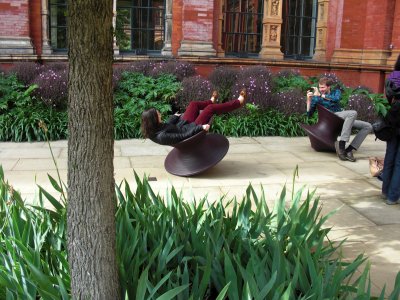 Here's one of the building's interior facades, viewed from across the courtyard, where we found a pair of vacant lawn chairs. The sunken area in the center of the open space is apparently ordinarily a water feature with fountains, but London is currently under water-conservation restrictions, so they were turned off and children were playing in the space. Out of sight to the right of the photo is an outdoor snack bar with tables and cafe umbrellas.
Here's one of the building's interior facades, viewed from across the courtyard, where we found a pair of vacant lawn chairs. The sunken area in the center of the open space is apparently ordinarily a water feature with fountains, but London is currently under water-conservation restrictions, so they were turned off and children were playing in the space. Out of sight to the right of the photo is an outdoor snack bar with tables and cafe umbrellas.
Out of sight to the left of the facade is the area shown above at the right, stocked with a couple of dozen of these intriguing objects, made of heavy-gauge plastic. They were perfectly usable as ordinarily outdoor seating, soothingly rockable side to side, but as children (and others) soon discovered, if you leaned back, lifted your feet, and shifted your weight, you could make them roll all the way around and around. They were more stable than they looked—even quite large and tall individuals spun them around safely, even very fast (each one stayed in exactly the same place; they didn't "creep"), but I saw one strapping young man who found a way to tip one over and dump himself out onto the concrete. He did it by bracing his feet against the inside rim and sliding himself up the opposite side (rather than settling his backside in the very bottom of the cone), placing his center of gravity quite high and and most of his weight on one side. A smaller person probably couldn't do it even that way. When one group of adults emerge from the building into the courtyard, a middle-aged lady glanced over and spotted people happily spinning themselves. Her eyes lit up, and she nudged another middle-aged lady in the group, or looked over and said, "Oh, wow!" The two made a bee-line for the rollers, waited for a vacancy, then took turns swiveling wildly and whooping with glee.
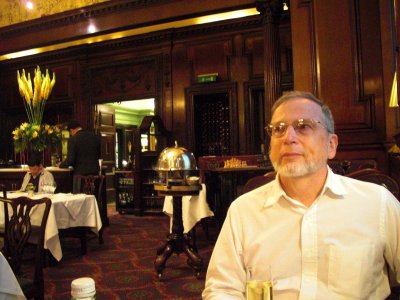
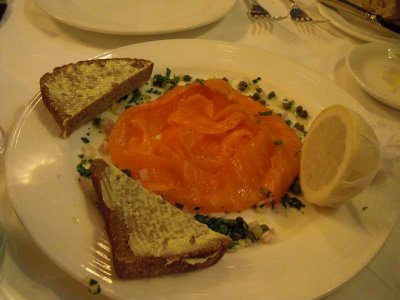 After our pleasant rest in the courtyard, we set off by underground for the theater district and our pre-theater dinner. For both Monday and Tuesday nights, we chose the legendary Simpson's in the Strand. (Its history page lists, as former guests, Vincent Van Gogh, Charles Dickens, Sherlock Holmes, George Bernard Shaw, Benjamin Disraeli and William Gladstone.) We made reservations for opening time, 5:45 p.m., so as to be sure to make our 7:30 p.m. curtain for Shrek. Here, David admires the lovely dining room (note the domed carving trolley in the background and the chess set on the piano next to it—Simpson's started life as a coffee house and chess den).
After our pleasant rest in the courtyard, we set off by underground for the theater district and our pre-theater dinner. For both Monday and Tuesday nights, we chose the legendary Simpson's in the Strand. (Its history page lists, as former guests, Vincent Van Gogh, Charles Dickens, Sherlock Holmes, George Bernard Shaw, Benjamin Disraeli and William Gladstone.) We made reservations for opening time, 5:45 p.m., so as to be sure to make our 7:30 p.m. curtain for Shrek. Here, David admires the lovely dining room (note the domed carving trolley in the background and the chess set on the piano next to it—Simpson's started life as a coffee house and chess den).
We started by sharing a plate of lovely smoked Scottish salmon with buttered brown bread. The green and white bits around the edge are capers, diced onion, and parsley, and the lemon half is wrapped in gauze so that the seeds could not fall into the food when it was squeezed.
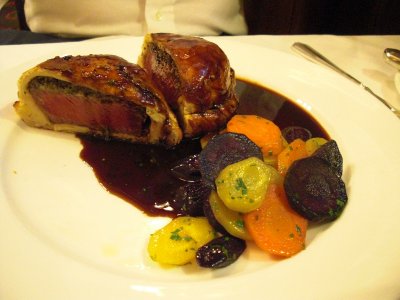
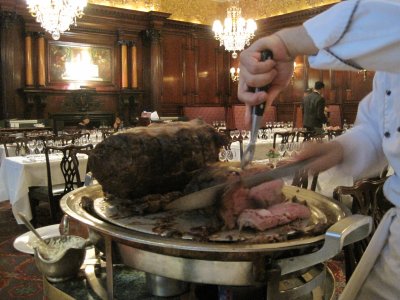 David then ordered beef Wellington, with which he was extraordinarily pleased. No shortcuts here—it was the full classic version, with liver paté and mushroom Duxelles. On the side were three colors of glazed carrots, all delicious.
David then ordered beef Wellington, with which he was extraordinarily pleased. No shortcuts here—it was the full classic version, with liver paté and mushroom Duxelles. On the side were three colors of glazed carrots, all delicious.
I ordered the roast beef. A master carver brought a plate bearing a Yorkshire pudding on out to the carving trolly, wheeled the trolley to our tableside, and, at my direction, carved off three slices of outstanding medium-rare beef (aged 28 days, according to the menu), ladled pan gravy over them, and added a generous dollop of house-made horseradish (from the sauceboat below and to the left of the platter of beef; the Yorkshire pudding is just visible between the sauceboat and the platter). Another waiter then arrived with a dish of Savoy cabbage and three crispy, spherical, roasted potatoes, very creamy-textured inside. The cabbage was undercooked and underseasoned, the Yorkshire pudding was no longer crisp (I can do better at home), but the potatoes, the horseradish, and the beef were superb! The horseradish was spicy enough to provide a kick but mild enough that you could eat enough of it actually to taste the horseradish and not just the peroxidases.
We skipped dessert, as we had to get to will-call in time to pick up our tickets (note to self: Brits have never heard the term "will-call"; they call it "pre-paid tickets").
Shrek! The Musical was great fun. Shrek was played by Oliver Eyre (apparently an understudy, as a special notice was posted at the entrance). It was mainly live-action, but a few puppets showed up (at one point, as characters from various fairy tales were going by the in the background (the cow jumped over the moon, and the dish went by griping that the spoon would never stop to ask directions), a life-size giraffe wandered through singing "Who's that green man?" to the tune of the Lion King opening theme and followed by a flight of that show's leaping-gazelle puppets. Just about the highlight of the show was the appearance of the dragon while Shrek is rescuing Fiona—she was a huge puppet (clothed in parachute silk?) worked by four men (who were visible but inconspicuous), and the effect was amazing! Her (excellent) singing voice was provided by an actress backstage who made her actual appearance only in the curtain calls.
The hilarious Robin Hood incident in the movie was replaced with a sequence involving the Pied Piper in which Fiona tap dances with a large herd of rats (portrayed at one point by a platoon of tap dancers wearing rat puppets on their feet and hidden from the audience by a curtain that revealed only their shoes and at another by fully visible dancers in tuxedos, rat ears, and whiskers).
The dragon's second appearance, the one where she appears at the last minute to eat Prince Farquad, took the form of a somewhat smaller (but still quite large) puppet that flew down from the top balcony, weaving and sweeping above the crowd before breathing fire onto the stage.
In the lobby you could buy stuffed animals of many of the characters, as well as headbands with ogre ears, some of which included pale-green bridal veils.
Unfortunately, most of the shows in the neighborhood ended just as Shrek did, and it rained at the same time. All the taxis queued in front of Covent Garden vanished in short order, and we couldn't even get into the nearby underground station, let alone down the stairs, along the corridors, onto the platform, and into a train! So we started walking west on Long Acre, managed to intercept a taxi on its way back to Covent Garden, and got home that way.
On the way, we noticed large numbers of police in clusters on street corners and in the parks, and as we got ready for bed, back in the hotel room, we opened the curtains in response to the sound of distant booms and saw part of the very top of a fireworks display, presumably over Hyde Park or thereabouts.
previous entry
List of Entries
next entry

 David had a pint of bitter and a "sausage butty" (i.e., a sandwich of split and flattened sausage on buttered bread). For an additional pound, he could have substituted fries for the salad, the opposite of the usual choice in the USA, where fries come standard and salad is extra.
David had a pint of bitter and a "sausage butty" (i.e., a sandwich of split and flattened sausage on buttered bread). For an additional pound, he could have substituted fries for the salad, the opposite of the usual choice in the USA, where fries come standard and salad is extra.




 After the Scott exhibition, we wandered through some of the other galleries (the dinosaurs were at the end of a queue of hundreds, with little kids in tow, presumably in town for jubilee, so we skipped that). At one point we encountered, down near the floor, glazed onto white tiles, along with many other images of nature, this gorgeous depiction of a wild ginger plant (at least that's what it's called in the U.S.; it's not the ginger of Asian cooking), slightly larger than life size. At another was this micrograph of a fly, way larger than life size.
After the Scott exhibition, we wandered through some of the other galleries (the dinosaurs were at the end of a queue of hundreds, with little kids in tow, presumably in town for jubilee, so we skipped that). At one point we encountered, down near the floor, glazed onto white tiles, along with many other images of nature, this gorgeous depiction of a wild ginger plant (at least that's what it's called in the U.S.; it's not the ginger of Asian cooking), slightly larger than life size. At another was this micrograph of a fly, way larger than life size.


 After lunch, we went to the Victoria and Albert museum, right across the street from the Natural History Museum. It has vast collections of, e.g., jewelry carved from shells and semiprecious stones, sculpture (monumental, miniature, and everything in between), "sacred silver" (reliquaries, monstrances, crosses and crucifixes, chalices, plates, etc.), jewelry, painting, stained glass, and "contemporary glass." In addition, in one courthyard is displayed an ancient wooden spiral staircase (now supported by a modern metal framework, as parts of it are missing) and in two other huge glass-roofed courtyards, called the "cast courts, " is a unique collection of plaster casts of monumental art. I don't know how they did it, but they had plaster casts of entire cathedral facades, tombs large and small, carved pillars 10 feet in diameter and three stories tall, a full-size Michelangelo's David—dozens and dozens of such items, all finished to look like the original material, whether stone, bronze, wood, or whatever. One of the cast courts was closed for maintenace, but we could walk around the other one both at floor level and around a balcony at second-story level. At the left here is one of a pair of carved columns, viewed from second-story level looking up toward third-story level (marked by the railing on the opposite wall. How in the world did they cast that?! At the right is the closed court, which we could see down into from the second-story level, for scale, note the young woman in a white coat who is crouching on the scaffolding below the left panel of the right-hand pediment (if that's what that thing to the right of the doorway is called). Below her, resting on the floor, is a collection of stone pulpits.
After lunch, we went to the Victoria and Albert museum, right across the street from the Natural History Museum. It has vast collections of, e.g., jewelry carved from shells and semiprecious stones, sculpture (monumental, miniature, and everything in between), "sacred silver" (reliquaries, monstrances, crosses and crucifixes, chalices, plates, etc.), jewelry, painting, stained glass, and "contemporary glass." In addition, in one courthyard is displayed an ancient wooden spiral staircase (now supported by a modern metal framework, as parts of it are missing) and in two other huge glass-roofed courtyards, called the "cast courts, " is a unique collection of plaster casts of monumental art. I don't know how they did it, but they had plaster casts of entire cathedral facades, tombs large and small, carved pillars 10 feet in diameter and three stories tall, a full-size Michelangelo's David—dozens and dozens of such items, all finished to look like the original material, whether stone, bronze, wood, or whatever. One of the cast courts was closed for maintenace, but we could walk around the other one both at floor level and around a balcony at second-story level. At the left here is one of a pair of carved columns, viewed from second-story level looking up toward third-story level (marked by the railing on the opposite wall. How in the world did they cast that?! At the right is the closed court, which we could see down into from the second-story level, for scale, note the young woman in a white coat who is crouching on the scaffolding below the left panel of the right-hand pediment (if that's what that thing to the right of the doorway is called). Below her, resting on the floor, is a collection of stone pulpits.
 height="300">In the gallery of semiprecious jewelry, we saw a wonderful collection of cameos, including this entire carved conch shell. Among the items of "sacred silver" was, somewhat incongruously, a six-inch cross clad entirely in bright red overlapping Coca Cola labels and titled "The Real Thing" (a wonderful pun, I thought, on that the many pieces of the "true cross" displayed in cathedrals all over the world). In the stained-glass section were very good videos showing the restoration of antique stained glass and some amazing examples of the very old "grisaille" technique of stained glass, in which the image was drawn on plain glass, then fused to it, sometimes with pale color washes over parts of the area. The images could be as detailed as woodcuts, and you don't usually get to see them so close up.
height="300">In the gallery of semiprecious jewelry, we saw a wonderful collection of cameos, including this entire carved conch shell. Among the items of "sacred silver" was, somewhat incongruously, a six-inch cross clad entirely in bright red overlapping Coca Cola labels and titled "The Real Thing" (a wonderful pun, I thought, on that the many pieces of the "true cross" displayed in cathedrals all over the world). In the stained-glass section were very good videos showing the restoration of antique stained glass and some amazing examples of the very old "grisaille" technique of stained glass, in which the image was drawn on plain glass, then fused to it, sometimes with pale color washes over parts of the area. The images could be as detailed as woodcuts, and you don't usually get to see them so close up.
 Already shown above, to the right of the conch shell, is a photo from my favorite section of the museum, a piece of contemporary glass by Dale Chihuly. Here are some more—I just can't stop clicking the shutter when faced with modern and art nouveau art glass. At the left are a glass and pitcher with decorative fishes in high relief on the outside. At the right, a vase with a thistle motif. Behind and to the left of the vase is a jar of some sort whose stopper is decorated with wide down-sweeping "wings" on which peacocks are etched. The heads are out of the frame, but you can see parts of the bodies and the tails, which continue down the wings.
Already shown above, to the right of the conch shell, is a photo from my favorite section of the museum, a piece of contemporary glass by Dale Chihuly. Here are some more—I just can't stop clicking the shutter when faced with modern and art nouveau art glass. At the left are a glass and pitcher with decorative fishes in high relief on the outside. At the right, a vase with a thistle motif. Behind and to the left of the vase is a jar of some sort whose stopper is decorated with wide down-sweeping "wings" on which peacocks are etched. The heads are out of the frame, but you can see parts of the bodies and the tails, which continue down the wings.
 Here, at the left is a sort of life-size glass mummy constructed of bent and molded rectangular glass panels hinged together with loops of wire.
Here, at the left is a sort of life-size glass mummy constructed of bent and molded rectangular glass panels hinged together with loops of wire.
 Here's one of the building's interior facades, viewed from across the courtyard, where we found a pair of vacant lawn chairs. The sunken area in the center of the open space is apparently ordinarily a water feature with fountains, but London is currently under water-conservation restrictions, so they were turned off and children were playing in the space. Out of sight to the right of the photo is an outdoor snack bar with tables and cafe umbrellas.
Here's one of the building's interior facades, viewed from across the courtyard, where we found a pair of vacant lawn chairs. The sunken area in the center of the open space is apparently ordinarily a water feature with fountains, but London is currently under water-conservation restrictions, so they were turned off and children were playing in the space. Out of sight to the right of the photo is an outdoor snack bar with tables and cafe umbrellas.
 After our pleasant rest in the courtyard, we set off by underground for the theater district and our pre-theater dinner. For both Monday and Tuesday nights, we chose the legendary Simpson's in the Strand. (Its history page lists, as former guests, Vincent Van Gogh, Charles Dickens, Sherlock Holmes, George Bernard Shaw, Benjamin Disraeli and William Gladstone.) We made reservations for opening time, 5:45 p.m., so as to be sure to make our 7:30 p.m. curtain for Shrek. Here, David admires the lovely dining room (note the domed carving trolley in the background and the chess set on the piano next to it—Simpson's started life as a coffee house and chess den).
After our pleasant rest in the courtyard, we set off by underground for the theater district and our pre-theater dinner. For both Monday and Tuesday nights, we chose the legendary Simpson's in the Strand. (Its history page lists, as former guests, Vincent Van Gogh, Charles Dickens, Sherlock Holmes, George Bernard Shaw, Benjamin Disraeli and William Gladstone.) We made reservations for opening time, 5:45 p.m., so as to be sure to make our 7:30 p.m. curtain for Shrek. Here, David admires the lovely dining room (note the domed carving trolley in the background and the chess set on the piano next to it—Simpson's started life as a coffee house and chess den).
 David then ordered beef Wellington, with which he was extraordinarily pleased. No shortcuts here—it was the full classic version, with liver paté and mushroom Duxelles. On the side were three colors of glazed carrots, all delicious.
David then ordered beef Wellington, with which he was extraordinarily pleased. No shortcuts here—it was the full classic version, with liver paté and mushroom Duxelles. On the side were three colors of glazed carrots, all delicious.